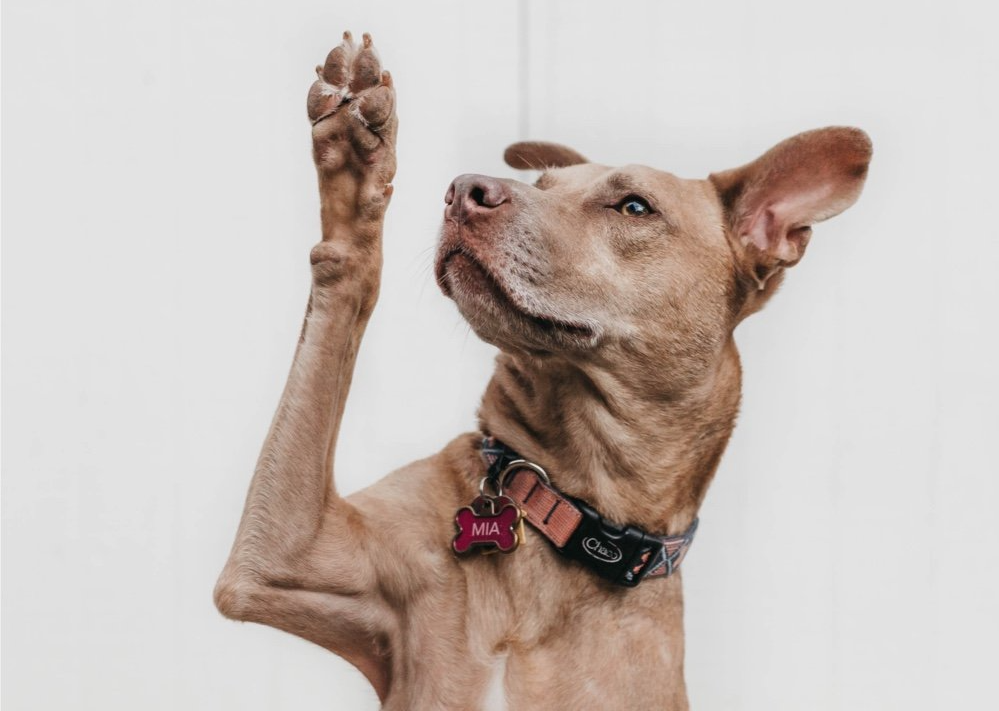Kate's Dog School Blog
Kate Stallworthy | 2025
Unveiling what dogs can't say
In the realm of canine companionship, words are replaced by a complex dance of body language. Our dogs can't vocalise their feelings, but they speak volumes through their postures, expressions and movements.
Delving into the world of canine body language isn't just a skill—it's a gateway to understanding our dogs on a profound level. By understanding their body language, we can connect with them on an emotional level, grasp their needs and ensure their well-being. It's important to understand the significance of assessing canine body language while considering context, objective versus subjective interpretation, repetition, frequency, combinations and the various cues that contribute to the fascinating conversation between dogs and humans.
A dog's eyes: Averted gaze or whale eye is an exposed white in the corner of a dog's eye and may indicate discomfort or anxiety, especially in certain contexts. Blinking eyes or squinting might show relaxation or submission. The direction of their gaze offers insight: focused attention signals curiosity, while a direct stare may denote assertiveness or even challenge. Context matters greatly; some breeds naturally display whale eye, highlighting the importance of considering breed-specific traits.
A dog's ears:
With about 18 muscles each, ears play a crucial role in conveying a dog emotions. It's important to combine ear cues with another component like eyes and bear in mind that different breeds have unique ear shapes. Pinned-back/down ears could indicate pain, stress or fear, while ears up and forward reflect alertness or curiosity. Stiff, upright ears suggest feeling threatened or intimidated. Ears down with no muscle tension signal calmness or relaxation while ears pointing backward might indicate escalating tension.
A dog's mouth: Nose or lip licking relieves stresses and could signify anxiety or appeasement. A dog's smile, often paired with panting indicates happiness, but if the corners of the mouth are pulled forward - it could signify escalation. Panting helps regulate temperature, but rapid panting might signify stress. Yawning may reflect stress and snarling communicates discomfort or warning. Snapping or biting reveals fear or defensiveness while chattering teeth might show over arousal. Each mouth behaviour carries distinct meanings, so observing in context is vital.
A dog's tail: It is best understood this component when paired with other cues. A tail held high often signals intimidation or threat. A tucked or lowered tail might signify fear or stress in a dog. Wagging tails carry varying meanings; fast wagging can imply enthusiasm, while slow or tense wags can convey caution. The direction of the wag, right or left, can reveal emotions—right suggests positive feelings, left may indicate uncertainty. Tail language is also breed-dependent, considering breed traits, tail size or docking. Generally, a calm dog often holds their tail midway.
A dog's coat: Assessing this is best when observed in conjunction with other body cues. Piloerection is when the hackles rise and all depends on where it is situated. Along the shoulder blades indicates a lack of confidence or fear. Down the back and tail suggests they are ready to take action. From the shoulder blades to the base of the tail can mean over arousal. While coat changes like shedding or diet play a role, altered patterns might indicate hormonal shifts, stress, health issues or even muscle changes.
A dog's posture: Leaning forwards indicates curiosity, while leaning away signifies caution or fear. Weight distribution, tense muscles or relaxation offer cues about comfort levels. Head tilting displays engagement. A shake-off might signal discomfort or release of tension, while hypervigilance suggests alertness or potential stress. Freezing denotes anxiety or a response to perceived threats. To understand a dog's state, it's best to observe posture, weigh it against other cues and consider the environment.
The art of reading dogs
Dogs are masters of nonverbal communication and learning their language is an art form that every dog lover should master.
Canine body language isn't a one-dimensional display—it's a symphony of cues that work together to convey emotions. By observing various cues simultaneously, we can unveil the full picture of what a dog is trying to communicate. By observing repetition, frequency, combinations of behaviours and putting all the cues together, we can accurately decipher what our dogs are communicating.
Kate's Dog School is here to help you dive into this remarkable world of body language and embark on a journey of shared understanding, compassion and friendship with our beloved dogs.

Book your free consultation today to discuss your dog's body language in more detail
Follow me
@katesdogschool
OPENING HOURS
- Mon - Fri
- -
- Saturday
- -
- Sunday
- Appointment Only




































































































